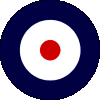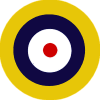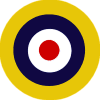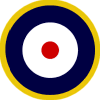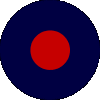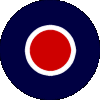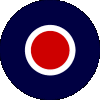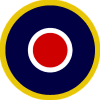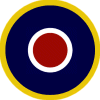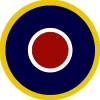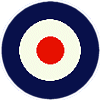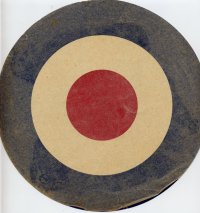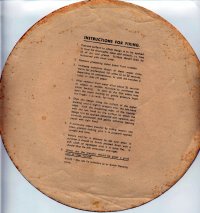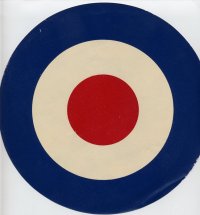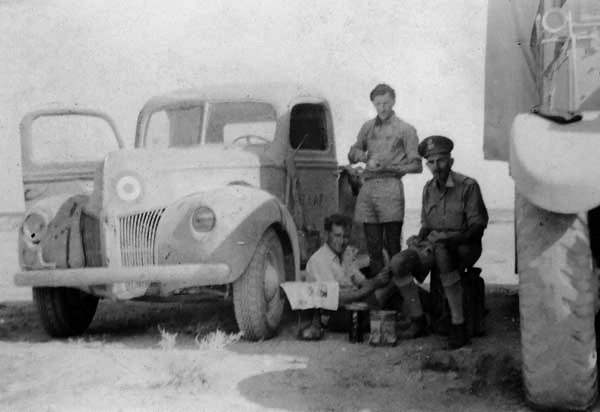




RAF Roundels 1939 - 1945
RAF roundel size and colour have changed many times since 1918. The 1939 to 1945 period was especially confusing with aircraft sporting standard patterns known as Type A, Type A1, Type B and Type C. The roundels shown below are those of the above types that I discovered so far, with dimensions supplied where known. Estimated figures are extrapolated from photographs.
Any confirmation of the data - or any amendments would be appreciated.
For a more detailed information on roundels I can recommend the articles at Camouflage and Markings
Note: The roundel types were not painted on aircraft as a set. After Type A there was a mixture of types painted on individual aircraft surfaces and some common patterns are illustrated by the aircraft examples at the bottom of the page. By May 1942, with the introduction of the Type C pattern, matters became more standardised - but aircraft retained Type B upper wing markings until April 1945.
Fin flashes are shown as viewed from the port side.
By Roundel Type
Dimensions in YELLOW are approximate.
|
Type A Roundel
Diameter |
WING UPPER |
|
Type A |
|
WING LOWER |
|
Type A
|
|
|
FUSELAGE |
|
Type A
|
|
|
FIN |
|
Type A |
|
|
Type A1 Roundel
Diameter |
WING UPPER |
|
Type A1 |
|
WING LOWER |
|
. |
|
|
FUSELAGE |
|
Type A1 |
|
|
|
Type
A1 Var.(Fighter Sqns) |
||
|
|
Type
A1 Var. |
||
|
FIN |
|
Type
A |
|
|
Type
B Roundel
Diameter |
WING UPPER |
|
Type
B
|
|
WING LOWER |
|
|
|
|
FUSELAGE |
|
Type B
|
|
|
FIN |
|
|
|
|
Type C Roundel
Diameter |
WING UPPER |
|
Type C
|
|
WING LOWER |
|
Type
C
|
|
|
FUSELAGE |
|
Type
C1
|
|
|
|
Type
C1
|
||
|
|
Type
C1 Bomber Var. |
||
|
FIN |
|
Type
C |
|
|
Type
D Roundel
Diameter |
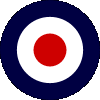 |
Type
D
|
|
|
SEAC |
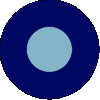 |
SEAC
|
|
|
Recent RAF Markings |
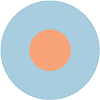 |
Gulf
War Standard Roundel |
|
 |
Gulf
War - Local Variant Applied in field |
||
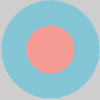 |
Front
Line Fighter and Patrol Aircraft Tornado F3s, Eurofighters and Nimrod |
||
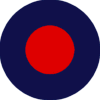 |
Front
Line Attack Aircraft Tornados and Jaguars, Chinooks, Pumas and Merlins of the Support Helicopter Force and Hercules transports. |
||
|
|
Transport
and Training Aircraft Thin white outline VIP aircraft (BAe 125s and BAe146s of No 32 Squadron), Tristars and training aircraft. |
||
By Aircraft Surface
|
|
Roundel
|
Type
(Figures in red are approximate)
|
|
WING UPPER |
|
Type
A |
|
|
Type
A1 |
|
|
|
Type
B |
|
|
|
Type
C |
|
|
|
||
|
WING LOWER |
|
Type
A |
|
|
Type
C |
|
|
|
||
|
FUSELAGE |
|
Type
A |
|
|
Type
A1 |
|
|
|
Type
A1 Var.(Fighter Sqns) |
|
|
|
Type
A1 Var. |
|
|
|
Type
B |
|
|
|
Type
C1 |
|
|
|
Type
C1 |
|
|
|
Type
C1 Bomber Var. |
|
|
|
||
|
FIN |
|
Type
A |
|
|
Type
C |
|
Examples
The examples are intended to show the diversity of markings - especially in the period up to 1942. It is not uncommon to find formation photographs showing quite different markings on individual aircraft.
|
|
Wing Upper |
Wing Lower |
Fuselage |
Fin |
|
June
1936 |
|
|
|
No flash |
|
1938 |
|
|
|
No flash |
|
June
1939 |
|
|
|
No flash |
|
Feb
1940 |
|
|
|
No flash |
|
July
1940 |
|
None |
|
No flash |
|
Sept
1940 |
|
|
|
|
|
April
1941 |
|
|
|
|
|
April
1941 |
|
|
|
|
|
May
1942 |
|
|
|
|
|
The Type C scheme was almost universally standard from 1942 to 1945. There were exceptions!
TransfersSteve White has been kind enough to send me photographs of a transfer used by the RAF in WW2. Click on each image for a full size version. The transfers are only 9" diameter and have Type D dimensions (colour diameters are in the ratio of 3:2:1). From viewer feedback it would appear that such transfers were primarily used on MT equipment such as the vehicle shown below. Photo courtesy of Keith Webb.
|
||||
